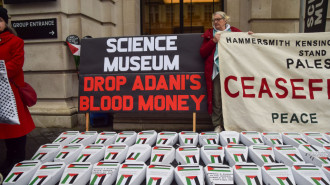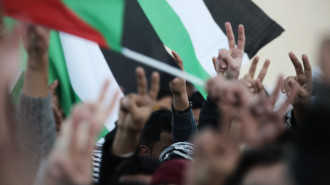Return to Tantura: Remembering the massacre of one Palestinian village and holding on to the right of return
In February, Zochrot (which means "remembering" in Hebrew), an Israeli NGO which educates on the Nakba and the right of return, arranged an educational tour of the site of the depopulated Palestinian village of Tantura, which used to lie on the coast south of Haifa, to the west of Furaydis village.
The tour aims to promote awareness of Tantura's history and the massacre which was carried out against the village inhabitants by Israeli forces immediately after the State of Israel was established.
Tantura's population was 1,720 before the Nakba, and the village agricultural lands amounted to 14,000 dunums: the villagers relied primarily upon farming and fishing before it was occupied by the Israeli army in May 1948.
All that remains of the village is the home of Ahmad al-Yahya, the school, and the shrine of al-Shaykh al-Bujayrmi (which now lies within the Dor seaside resort village). Most of its inhabitants were expelled to camps throughout the Arab world, but some remained close by, today living in the village of Furaydis and other villages in 1948 Palestine (present-day Israel).
"Tantura's population was 1,720 before the Nakba, and the village agricultural lands amounted to 14,000 dunums: the villagers relied primarily upon farming and fishing before it was occupied by the Israeli army in May, 1948"
Erasing the past: Building atop Tantura's ruins
Today, Nahsholim settlement sits where Tantura used to be, and the former village lands also are home to a hotel, a tourist resort and a village for the fishermen, which fishermen from Furaydis nearby benefit from. The site is renowned for its beautiful beaches.
The tour begins in the car park which was the spot on which the massacre took place in 1948, and afterwards became the site of the mass grave. One of those taking part placed a sign, stating "Tantura Cemetery" in the ground there, before the group headed to where the village mosque used to be on the southeast side of the car park, where they erected another sign, stating the name of the mosque. Finally, they gathered on the beach, in order to see the one Palestinian house still standing: that of Ahmad Yahya, a former Tantura resident, and the shrine of al-Shaykh al-Bujayrmi, inside the tourist resort.
Hiding the truth
Umar Al-Ghubari, the Zochrot tour guide, said: "We are standing on the land of Tantura cemetery, it begins in the car park, and it ends inside the grounds of Nahsholim Hotel which was built on top of Tantura immediately after 1948. Imagine, the cemetery lies right here, under the feet of everyone who visits, without the owners of the hotel ever daring to tell its guests the story."
Al-Ghubari mentions the discussion that was provoked by the recent Hebrew-language documentary Tantura, directed by Alon Shwartz, which "reveals what happened in Tantura with eyewitness accounts from the criminals who took part." He continues: "As Palestinians, we must seize this chance to build on the knowledge and awareness people have of the Nakba, the crimes of the Nakba and the massacre at Tantura."
A village renowned for its beauty
Al-Ghubari adds: "Tantura was well known as one of the most beautiful of Palestine's coastal villages, and this is according to testimonies from the refugees but even from Israeli settlers who admired the village with its attractive houses and innovative architecture. Unfortunately, Tantura's idyllic description is now associated with the horrific massacre there, and the trauma left behind after the catastrophe which befell this village."
Al-Ghubari recalls the horrors of the massacre, the merciless killing of men and women which took place: "We are talking 200 to 250 inhabitants murdered, including two women, Izzat al-Hajj and her sister."
When we say #OngoingNakba this is what we mean: It's not just police brutality & physical harm to Palestinians but what's behind these atrocities: denying Palestinians the right to gather in their own city, the right to celebration & joy. A logic of elimination. #Nakba #Jerusalem https://t.co/Gtll0pgthv
— ذاكرات זוכרות Zochrot #ExposeJNF (@Zochrot) March 1, 2022
Realising the right of return
Rachel Beitarie, director of Zochrot said: "Israeli society denies the crimes of the Nakba, we see this continue today. And the Nakba is ongoing, every day. For instance, Mohammed Shehadeh, a child from the Al Khader village was killed recently. Our role is to teach the next generation and remind them of the crimes of the Nakba and of the right of return."
According to Zochrot's written statement, "Visiting Tantura at this time is not only about learning history but an action towards acknowledging the truth – recognising it and taking responsibility for it by realising the right of return and rebuilding of the new village of Tantura."
It adds: "Tantura is not just a film, nor a history that has vanished, but rather an open wound and an ongoing injustice. Tantura is not an exception or an isolated case, but rather is one of the many bloody chapters in the context of the Nakba."
This is an edited translation from our Arabic edition. To read the original article click here.
Translated by Rose Chacko
This article is taken from our Arabic sister publication, Al-Araby Al Jadeed and mirrors the source's original editorial guidelines and reporting policies. Any requests for correction or comment will be forwarded to the original authors and editors.
Have questions or comments? Email us at: info@alaraby.co.uk


